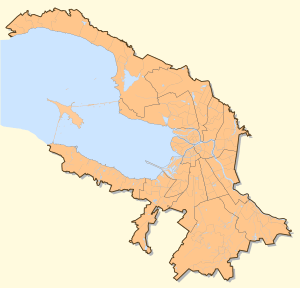Beloostrov
Beloostrov (Russian: Белоо́стров; Finnish: Valkeasaari, both meaning lit. White Island), from 1922 to World War II—Krasnoostrov (Красноо́стров, lit. Red Island), is a municipal settlement in Kurortny District of the federal city of St. Petersburg, Russia, located on the Sestra River, Karelian Isthmus. Population: 2,080 (2010 Census);[1] 1,690 (2002 Census);[2] 1,405 (1989 Census).[3]

History
Beloostrov historically consists of two parts: Novy Beloostrov (Russian: Но́вый Белоо́стров, New White Island; Finnish: Uusi Valkeasaari) along the railway and Stary Beloostrov (Russian: Ста́рый Белоо́стров, Old White Island; Finnish: Vanha Valkeasaari) several kilometers to the north, mostly belonging to Vsevolozhsky District of Leningrad Oblast under the name Sadovodstva (Russian: Садоводства). Until the Winter War Beloostrov was the last railway station before the Russia–Finland border.
Transportation
Beloostrov has been a key station of the Saint Petersburg-Vyborg railroad since 1870 (initially named Rayala (Finnish: Rajala)) at the junction of Saint Petersburg–Zelenogorsk and Saint Petersburg–Sestroretsk–Beloostrov sections, being the final destination of many suburban passenger electric trains from the Finland Railroad Station.
References
- Russian Federal State Statistics Service (2011). "Всероссийская перепись населения 2010 года. Том 1" [2010 All-Russian Population Census, vol. 1]. Всероссийская перепись населения 2010 года [2010 All-Russia Population Census] (in Russian). Federal State Statistics Service.
- Russian Federal State Statistics Service (May 21, 2004). "Численность населения России, субъектов Российской Федерации в составе федеральных округов, районов, городских поселений, сельских населённых пунктов – районных центров и сельских населённых пунктов с населением 3 тысячи и более человек" [Population of Russia, Its Federal Districts, Federal Subjects, Districts, Urban Localities, Rural Localities—Administrative Centers, and Rural Localities with Population of Over 3,000] (XLS). Всероссийская перепись населения 2002 года [All-Russia Population Census of 2002] (in Russian).
- "Всесоюзная перепись населения 1989 г. Численность наличного населения союзных и автономных республик, автономных областей и округов, краёв, областей, районов, городских поселений и сёл-райцентров" [All Union Population Census of 1989: Present Population of Union and Autonomous Republics, Autonomous Oblasts and Okrugs, Krais, Oblasts, Districts, Urban Settlements, and Villages Serving as District Administrative Centers]. Всесоюзная перепись населения 1989 года [All-Union Population Census of 1989] (in Russian). Институт демографии Национального исследовательского университета: Высшая школа экономики [Institute of Demography at the National Research University: Higher School of Economics]. 1989 – via Demoscope Weekly.
.svg.png)
